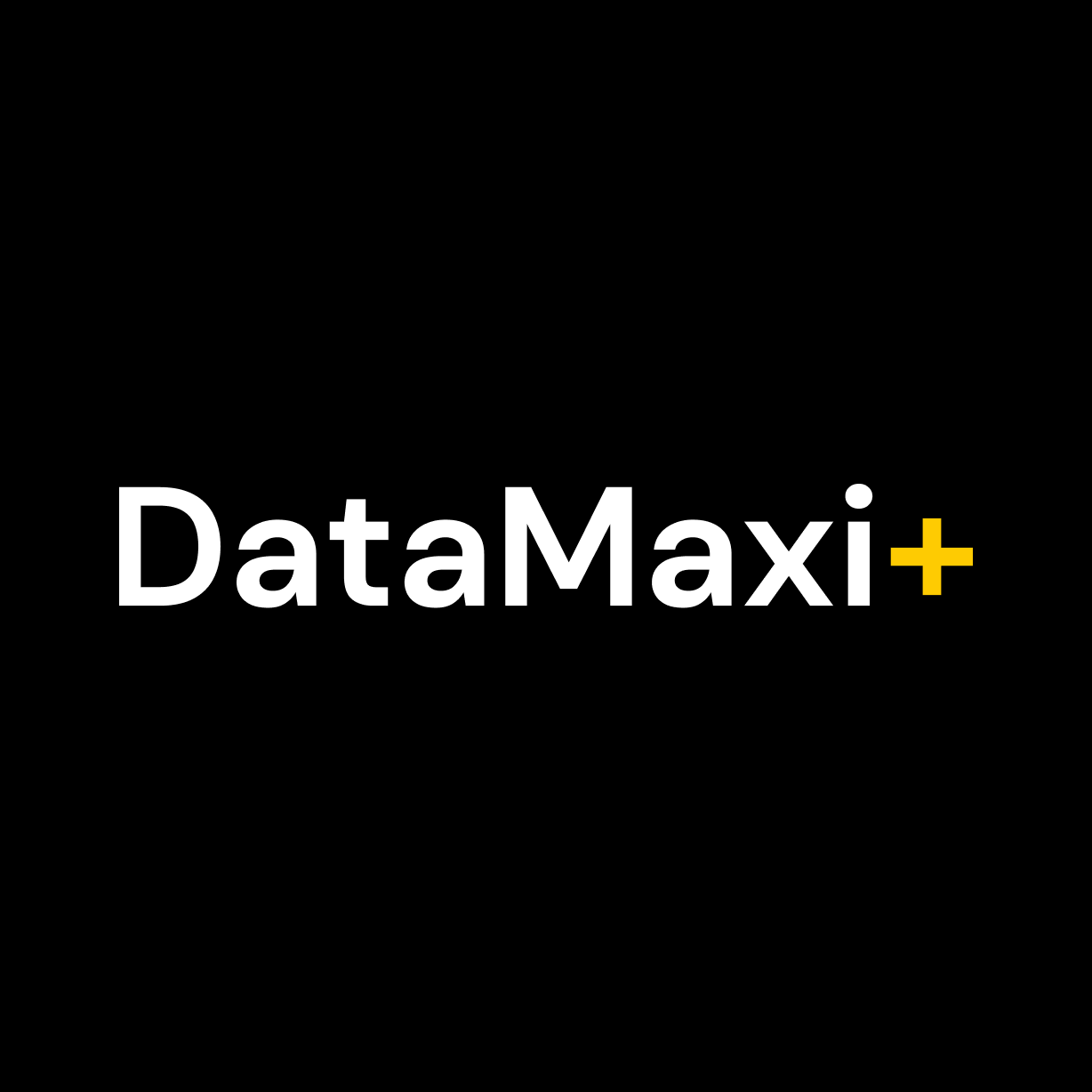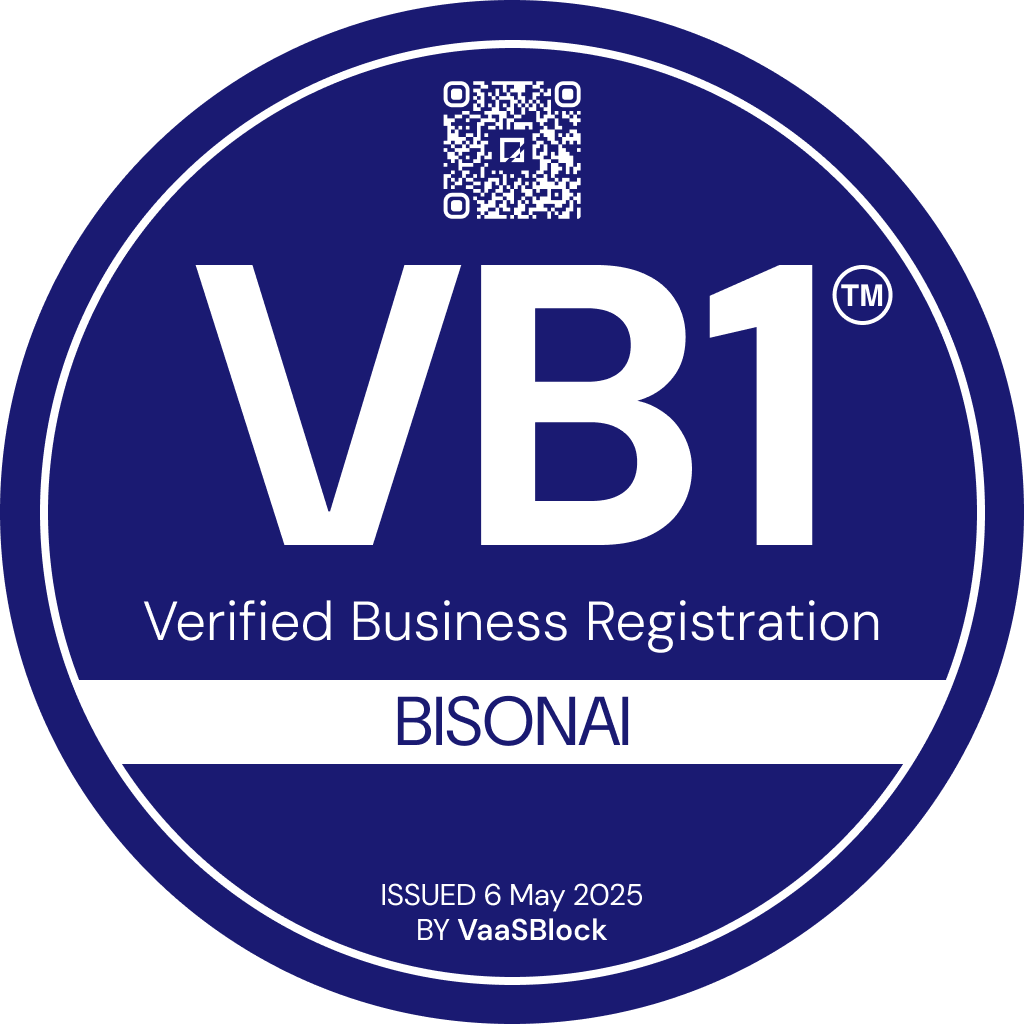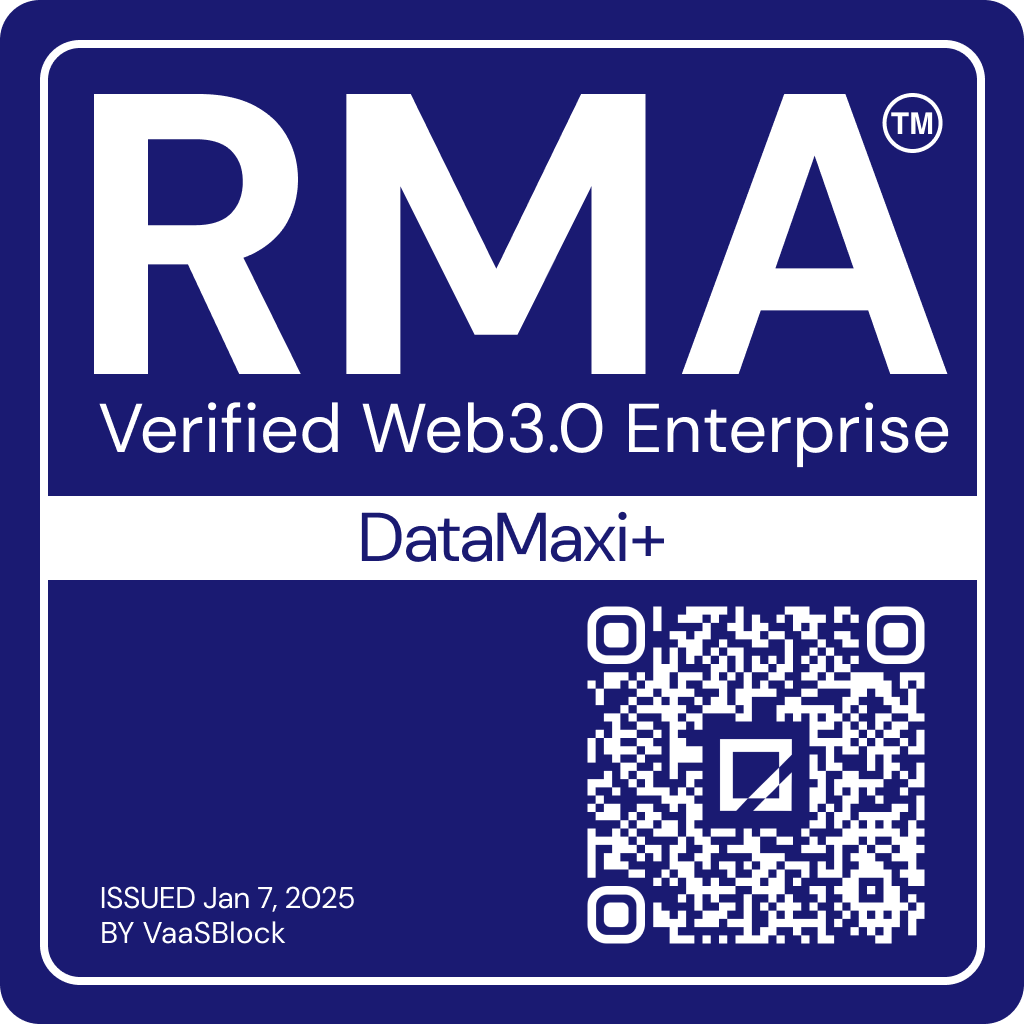
DataMaxi+
Risk Management
?Risk Management
The RMA™ is a blockchain credibility certification assessing governance, transparency, security, and results, providing trusted verification for businesses in Web3.
Analysis based on information collected and audited by VaaSBlock.

RMA™ Status: ✔ Active
Verification of 6 major compliance criteria.
Technology
?Technology
A collection of public facing information, data collected through partners and our own tools view we present a projects technology in one place for easy verification.
Analysis and testing of tech infrastructures.
Marketing
Alpha?Marketing
Top level look at a projects marketing capablities currently in alpha this section will grow to show quickly how a project promotes itself and the effectiveness.
Screening of user base and community feedback.
Background
?Background
Using multiple public facing sources across the web view a summary of a projects purpose, key achievements and general overview.
Collection of basic administrative documentation.
Risk Management
Last Updated
2025/07/14
Transparency
Transparency Score
Algorithmic assessment of a project’s transparency level, using multiple public data points to measure its commitment to compliance, documentation, and clarity in communication.
Transparency Score
Category Rank
A ranking that positions the organization among its industry peers, evaluating its relative performance based on key compliance, credibility, and transparency indicators.
Category Rank
DataMaxi+ vs Data & Analytics
VaaSBlock Rank
A global ranking that compares the organization against all entities listed on VaaSBlock, reflecting its overall credibility, transparency, and operational performance versus the full Web3 ecosystem.
VaaSBlock Rank
DataMaxi+ vs All Listed Organizations
Transparency
Transparency Score
Transparency Score
Algorithmic assessment of a project’s transparency level, using multiple public data points to measure its commitment to compliance, documentation, and clarity in communication.
Category Rank
DataMaxi+ vs Data & Analytics
Category Rank
A ranking that positions the organization among its industry peers, evaluating its relative performance based on key compliance, credibility, and transparency indicators.
VaaSBlock Rank
DataMaxi+ vs All Listed Organizations
VaaSBlock Rank
A global ranking that compares the organization against all entities listed on VaaSBlock, reflecting its overall credibility, transparency, and operational performance versus the full Web3 ecosystem.
RMA™
Contract – ![]() 0x89584b…89bc2048
0x89584b…89bc2048
Mint date – 01/06/2025
Token – ![]() 0x89584b…89bc2048/27
0x89584b…89bc2048/27
Full Report – ✘ Not available
Learn how to verify an RMACorporate Governance
The verification of fundamental governance, organizational structure, including verifying the entity’s legal registration and adherence to local laws and regulations.
Corporate
Governance

Team Proficency
Evaluation of an organization’s personnel, ensuring that crucial team members possess the expertise and dedication necessary to execute current business models and scale effectively.
Team
Proficiency

Technology & Security
Assessment of the organization’s technological framework, including blockchain integrations (where relevant), system architecture, and overall IT infrastructure.
Technology
& Security

Revenue Model
Comprehensively evaluation of a company’s income-generating strategies (how do they make or intend to make money), ensuring financial robustness and sustainability.
Revenue
Model

Results Delivered
The Results Delivered component of the RMA™ audit comprehensively evaluates an organization’s ability to achieve its goals and honor its commitments.
Results
Delivered

Planning & Transparency
The Planning and Transparency component of the RMA™ audit offers a thorough assessment of how an organization manages its workflow and prepares for unexpected challenges.
Planning &
Transparency

Business Registration
Registration Country – SG
Document Sited – sgpbusiness.com
Registration date – 02/18/2023
Contract – ![]() 0xd36f3b…4e203c0d
0xd36f3b…4e203c0d

Minted: 05/05/2025
RMA™ Announcement
VaaSBlock is pleased to announce that DataMaxi+, an advanced crypto data analytics platform, has been awarded the prestigious RMA™ (Risk Management Authentication). This milestone underscores DataMaxi… [Read More]
Technology
Website
Domain First Registered – April 2024
SSL Status – ✔ Secure
Source Code
GitHub = ✔ Available – View Code
Marketing
DataMaxi+

https://www.linkedin.com/posts/vaasblock_datamaxi-receives-rma-certification-from-activity-7282299754338816000-m9kr
3K
Followers
2-10
Associated Members
No Chain No Gain™ Podcast ⛉
This Organization is yet to join the No Chain No Gain™ Podcast and share insights on what makes their business trustable and innovative.
💡 NCNG generated over 1 Million impressions in its first six months of existence.
PR Impact
PR Impact
VaaSBlock provides estimations to the impact that traditional digital media can have on a project. This is an early release; more areas of PR are planned in future versions.
Search Terms ? Search TermsThese are the terms we discovered the article for on page one of Google. | Est. Traffic ? Estimated TrafficWe estimate how much traffic an article will get. Generally, our estimations are slightly higher than those of more established tools. We are working on the algorithm all the time, and results could change. | Est. Value ? Estimated ValueBased on the estimated traffic we generate an estimation for what this traffic would have cost to generate if you tried to target these users with ads. The positions for the article on google and the location of the traffic are the major factors in this estimation. | |||
|---|---|---|---|---|---|
Kevin Ahn, Co-founder of VaaSBlock source: vaasblock.com | Kevin Ahn, Co-founde… — Kevin Ahn, Co-founder of VaaSBlock source: vaasblock.com | Organic | vaasblock.com | ||
Datamaxiplus source: Sotwe | Datamaxiplus… — Datamaxiplus source: Sotwe | Organic | sotwe.com | ||
DataMaxi+ – RMA Verified Excellence: Secure, Audited, and Trusted for Investment Growth. source: irmaAI | DataMaxi+ – RMA Veri… — DataMaxi+ – RMA Verified Excellence: Secure, Audited, and Trusted for Investment Growth. source: irmaAI | Organic | vaasblock.com | ||
BISONAI source: github.com | BISONAI… — BISONAI source: github.com | Organic | github.com |
| Est. Traffic | Est. Value | ||
|---|---|---|---|
Kevin Ahn, Co-founde… — | |||
Datamaxiplus… — | |||
DataMaxi+ – RMA Veri… — | |||
BISONAI… — |
Background
Organization Name – DataMaxi+
Category –  Data & Analytics
Data & Analytics
About
powered by irmaAI
irmaAIDataMaxi+ presents itself as an early‑stage crypto data‑analytics service that wants to give traders institutional‑grade market intelligence at retail speed and cost. According to company record…s, the project soft‑launched in Seoul in April 2024, when founder and chief executive Bryan Kim—also the CEO of Web3 infrastructure firm Bisonai—unveiled an “arbitrage‑first data stack” during the IXO™ 2024 road‑show in Seoul, telling the audience he was building “a comprehensive solution for Kimchi‑premium trading and other quantitative strategies”
From that pitch grew a public web app and an API suite that now operate under the DataMaxi+ brand. The landing page showcases dashboards that track real‑time price gaps across major exchanges, funding‑rate extremes, and what the team calls Korea‑premium indices—charts that compare Bitcoin, Ether and other large‑cap tokens on Upbit against global venues such as Binance to infer domestic retail sentiment
Users can filter instruments, drill into spread history, and set alerts, while a companion “Exchange Events” feed aggregates listing notices and promotional campaigns so that short‑term traders see hard‑to‑arb announcements alongside price data
Under the hood, DataMaxi+ leans on open‑source tooling. Bisonai maintains the official Python SDK on GitHub and publishes the package on PyPI, allowing quants to fetch metrics or stream WebSocket data into their own models with a few lines of code
The documentation site explains that the same endpoints are mirrored in a Rust library and that calls can be authenticated with free keys during what the team labels a proof‑of‑concept period; enterprise plans are available for firms that need higher‑rate limits or commercial redistribution rights
Beyond exchange feeds, the roadmap hints at on‑chain coverage—address balances, DEX volumes, gas metrics—and the company is actively recruiting “data partners” willing to share token‑ecosystem or liquidity‑pool statistics in exchange for traffic and co‑marketing Kim has said publicly that the long‑term vision is to fuse centralised and decentralised data into a single pane so that traders can spot arbitrage windows not only between order‑book venues but also between CEXs and AMMs, something few analytics suites attempt at scale.
Security and governance have been early selling points. In January 2025 DataMaxi+ became one of the youngest analytics players to earn VaaSBlock’s RMA™ badge after auditors evaluated its corporate controls, revenue disclosures, technology safeguards and team proficiency; VaaSBlock reported that the platform exceeded expectations in the “Results Delivered” category, citing transparent uptime logs and public SDK repositories
Kim described the certification as “critical for winning the confidence of institutional counterparties” in a LinkedIn post that VaaSBlock amplified in its own announcement thread, arguing that data‑feeds used for risk‑managed strategies should themselves be independently verified
While RMA remains a relatively new framework, the endorsement aligns with DataMaxi+’s decision to publish its client libraries under the permissive MIT licence—anyone can inspect the code path from API request to JSON payload.
Functionally, the product splits into Maxi Analytics, a browser GUI geared toward discretionary traders, and Maxi API, the machine‑to‑machine layer that quants or fintech apps can embed. Documentation advertises latency in the low hundreds of milliseconds and fail‑over nodes in Singapore and Virginia, though these numbers are self‑reported. Feature highlights include a “Wonsangttari Premium” widget that charts real‑time spreads between Korean won‑denominated stablecoins and their USD counterparts, and a funding‑rate screener that flags perpetual markets trading 100 bps above or below their eight‑hour average
The company claims these datasets help users time entries on popular basis trades—long spot, short perps—or hedge directional portfolios by shorting over‑funded coins. For analysts who prefer raw CSVs, the site offers one‑click downloads and promises S3 bucket sync for enterprise tiers.
Early traction has centred on the Korean market, where the so‑called Kimchi premium often reaches several percentage points and local traders scour Telegram for real‑time feeds. LinkedIn posts from Bisonai staff say the service already integrates data from “major domestic and international exchanges” and supports both retail dashboards and institutional risk panels
In April 2025 the Hong‑Kong–licensed exchange HashKey Global announced a strategic partnership with Bisonai to embed DataMaxi+’s analytics into its order‑routing fabric, calling the move a step toward “data‑driven trading infrastructure” for professional clients
Observers viewed the alliance as validation that DataMaxi+ can serve a regulated venue with strict compliance requirements.
Though now an independent brand, DataMaxi+ still taps Bisonai’s broader product suite, which includes a blockchain oracle network and the Klaytnfinder block explorer. Bisonai positions itself as a full‑stack data company, so DataMaxi+ benefits from shared back‑end services and DevOps resources
The synergy surfaced again when the GitHub repo credited four Bisonai engineers for the SDK release and advertised forthcoming support for account‑abstraction wallets and MPC signing, hinting that secure trade automation is on the horizon
Commercial questions remain. The website currently grants PoC‑level API keys at no cost and only teases paid tiers, raising the unavoidable matter of how and when to monetise
Kim told the IXO audience that the initial priority is network effect: “capture the eyeballs of traders who refresh Bybit spreads every thirty seconds,” then upsell premium latency or bespoke datasets
A pricing FAQ invites enterprise users to negotiate customised plans, suggesting the team is courting OTC desks, market makers and quant funds willing to pay for Critical mass will be essential; arbitrage leads decay in seconds, so if the feed is slow or coverage incomplete, professional traders will churn. Competing products like Kaiko or Coin Metrics already enjoy multi‑year head starts, though they often charge four‑figure sums for similar datasets—an opening DataMaxi+ hopes to exploit by remaining aggressively priced.
Regulation, too, looms. Market‑data vendors fall into a grey zone, but as Korean authorities tighten oversight of crypto derivatives and premium trades, data platforms that explicitly facilitate arbitrage may attract scrutiny. The RMA badge shows proactive self‑regulation, yet DataMaxi+ has not announced ISO‑27001 certification or SOC 2 audits, both common for Western data firms. Any move to issue a native token or facilitate trade execution—as hinted in a recent community AMA—would invite a new layer of compliance complexity. For now the service stops at analytics, content to send users back to exchanges for execution.
Despite these caveats, DataMaxi+ offers a compelling glimpse of where crypto data tooling is headed. Its cross‑venue spread engine targets a persistent inefficiency unique to Korea’s retail‑heavy market; its API and open‑source SDKs lower the barrier for hobbyist quants; and its early partnership pipeline suggests institutional appetite. If the team can convert its free‑tier user base into paying customers while maintaining the transparency standards that secured its RMA certification, it might carve out a profitable niche in the crowded analytics arena. The next milestones—rolling out on‑chain data, delivering promised latency SLAs, and publishing independent security audits—will determine whether DataMaxi+ remains a beta‑stage curiosity or graduates into a durable piece of trading infrastructure in Asia’s fast‑moving crypto landscape Read More
Creation Date
December 2025
Headquarters
Seoul, Republic of Korea
Organization Maturity Level
Early-Stage
RMA™ Type
Self-Assessment
Useful Links
Website – datamaxiplus.com
Notable Achievements
2024
Soft-launch of DataMaxi+ web app featuring real-time CEX spread dashboards and the first “Korea-Premium” indices.
2025
DataMaxi+ earns the VaaSBlock RMA™ certification, exceeding standards in “Results Delivered” thanks to transparent uptime logs and open repositories.
2025
Strategic partnership announced with HashKey Global – exchange embeds DataMaxi+ analytics into its order-routing engine for professional clients
- vaasblock.com /
- Data & Analytics /
- DataMaxi+



